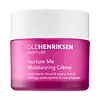What's inside
What's inside
 Key Ingredients
Key Ingredients

 Benefits
Benefits

 Concerns
Concerns

 Ingredients Side-by-side
Ingredients Side-by-side

Water
Skin ConditioningSqualane
EmollientGlycerin
HumectantCaprylic/Capric Triglyceride
MaskingIsoamyl Laurate
EmollientButyrospermum Parkii Butter
Skin ConditioningSorbitan Olivate
EmulsifyingCetearyl Olivate
Ceramide NP
Skin ConditioningJojoba Esters
EmollientSodium Hyaluronate
HumectantEuterpe Oleracea Sterols
Skin ConditioningLinoleic Acid
CleansingOleic Acid
EmollientLinolenic Acid
CleansingEthyl Linoleate
EmollientTocopherol
AntioxidantIsoamyl Cocoate
Cetyl Palmitate
EmollientSorbitan Palmitate
EmulsifyingCetearyl Alcohol
EmollientEthylhexylglycerin
Skin ConditioningCarbomer
Emulsion StabilisingSodium Hydroxide
BufferingPhenoxyethanol
PreservativeSodium Gluconate
Skin ConditioningWater, Squalane, Glycerin, Caprylic/Capric Triglyceride, Isoamyl Laurate, Butyrospermum Parkii Butter, Sorbitan Olivate, Cetearyl Olivate, Ceramide NP, Jojoba Esters, Sodium Hyaluronate, Euterpe Oleracea Sterols, Linoleic Acid, Oleic Acid, Linolenic Acid, Ethyl Linoleate, Tocopherol, Isoamyl Cocoate, Cetyl Palmitate, Sorbitan Palmitate, Cetearyl Alcohol, Ethylhexylglycerin, Carbomer, Sodium Hydroxide, Phenoxyethanol, Sodium Gluconate
Water
Skin ConditioningHelianthus Annuus Seed Oil
EmollientGlycerin
HumectantDimethicone
EmollientGlyceryl Stearate Se
EmulsifyingCyclopentasiloxane
EmollientRosa Canina Fruit Oil
EmollientCetearyl Alcohol
EmollientCetyl Alcohol
EmollientParfum
MaskingCeteareth-20
CleansingPhenoxyethanol
PreservativeOenothera Biennis Oil
EmollientAllantoin
Skin ConditioningTriticum Vulgare Germ Oil
EmollientCarbomer
Emulsion StabilisingPanthenol
Skin ConditioningCaprylyl Glycol
EmollientHexylene Glycol
EmulsifyingEthylhexylglycerin
Skin ConditioningEthylhexyl Methoxycinnamate
UV AbsorberTocopheryl Acetate
AntioxidantCitrus Grandis Fruit Extract
AstringentCitrus Aurantium Dulcis Fruit Extract
MaskingChamomilla Recutita Flower Extract
MaskingCalendula Officinalis Flower Extract
MaskingRetinyl Palmitate
Skin ConditioningCitric Acid
BufferingTocopherol
AntioxidantCI 15985
Cosmetic ColorantAscorbyl Palmitate
AntioxidantCI 16035
Cosmetic ColorantBHT
AntioxidantBenzyl Benzoate
AntimicrobialCitral
PerfumingLimonene
PerfumingLinalool
PerfumingWater, Helianthus Annuus Seed Oil, Glycerin, Dimethicone, Glyceryl Stearate Se, Cyclopentasiloxane, Rosa Canina Fruit Oil, Cetearyl Alcohol, Cetyl Alcohol, Parfum, Ceteareth-20, Phenoxyethanol, Oenothera Biennis Oil, Allantoin, Triticum Vulgare Germ Oil, Carbomer, Panthenol, Caprylyl Glycol, Hexylene Glycol, Ethylhexylglycerin, Ethylhexyl Methoxycinnamate, Tocopheryl Acetate, Citrus Grandis Fruit Extract, Citrus Aurantium Dulcis Fruit Extract, Chamomilla Recutita Flower Extract, Calendula Officinalis Flower Extract, Retinyl Palmitate, Citric Acid, Tocopherol, CI 15985, Ascorbyl Palmitate, CI 16035, BHT, Benzyl Benzoate, Citral, Limonene, Linalool
 Reviews
Reviews

Ingredients Explained
These ingredients are found in both products.
Ingredients higher up in an ingredient list are typically present in a larger amount.
Carbomer is a polymer of acrylic acid. Its main role is to create a gel consistency.
A high amount of carbomer can cause pilling or balling up of products. Don't worry, most products contain 1% or less of carbomer.
Cetearyl alcohol is a mixture of two fatty alcohols: cetyl alcohol and stearyl alcohol. It is mainly used as an emulsifier. Emulsifiers help prevent the separation of oils and products. Due to its composition, it can also be used to thicken a product or help create foam.
Cetearyl alcohol is an emollient. Emollients help soothe and hydrate the skin by trapping moisture.
Studies show Cetearyl alcohol is non-toxic and non-irritating. The FDA allows products labeled "alcohol-free" to have fatty alcohols.
This ingredient is usually derived from plant oils such as palm, vegetable, or coconut oils. There is debate on whether this ingredient will cause acne.
Due to the fatty acid base, this ingredient may not be Malassezia folliculitis safe.
Learn more about Cetearyl AlcoholEthylhexylglycerin (we can't pronounce this either) is commonly used as a preservative and skin softener. It is derived from glyceryl.
You might see Ethylhexylglycerin often paired with other preservatives such as phenoxyethanol. Ethylhexylglycerin has been found to increase the effectiveness of these other preservatives.
Glycerin is already naturally found in your skin. It helps moisturize and protect your skin.
A study from 2016 found glycerin to be more effective as a humectant than AHAs and hyaluronic acid.
As a humectant, it helps the skin stay hydrated by pulling moisture to your skin. The low molecular weight of glycerin allows it to pull moisture into the deeper layers of your skin.
Hydrated skin improves your skin barrier; Your skin barrier helps protect against irritants and bacteria.
Glycerin has also been found to have antimicrobial and antiviral properties. Due to these properties, glycerin is often used in wound and burn treatments.
In cosmetics, glycerin is usually derived from plants such as soybean or palm. However, it can also be sourced from animals, such as tallow or animal fat.
This ingredient is organic, colorless, odorless, and non-toxic.
Glycerin is the name for this ingredient in American English. British English uses Glycerol/Glycerine.
Learn more about GlycerinPhenoxyethanol is a preservative that has germicide, antimicrobial, and aromatic properties. Studies show that phenoxyethanol can prevent microbial growth. By itself, it has a scent that is similar to that of a rose.
It's often used in formulations along with Caprylyl Glycol to preserve the shelf life of products.
Tocopherol (also known as Vitamin E) is a common antioxidant used to help protect the skin from free-radicals and strengthen the skin barrier. It's also fat soluble - this means our skin is great at absorbing it.
Vitamin E also helps keep your natural skin lipids healthy. Your lipid skin barrier naturally consists of lipids, ceramides, and fatty acids. Vitamin E offers extra protection for your skin’s lipid barrier, keeping your skin healthy and nourished.
Another benefit is a bit of UV protection. Vitamin E helps reduce the damage caused by UVB rays. (It should not replace your sunscreen). Combining it with Vitamin C can decrease sunburned cells and hyperpigmentation after UV exposure.
You might have noticed Vitamin E + C often paired together. This is because it is great at stabilizing Vitamin C. Using the two together helps increase the effectiveness of both ingredients.
There are often claims that Vitamin E can reduce/prevent scarring, but these claims haven't been confirmed by scientific research.
Learn more about TocopherolWater. It's the most common cosmetic ingredient of all. You'll usually see it at the top of ingredient lists, meaning that it makes up the largest part of the product.
So why is it so popular? Water most often acts as a solvent - this means that it helps dissolve other ingredients into the formulation.
You'll also recognize water as that liquid we all need to stay alive. If you see this, drink a glass of water. Stay hydrated!
Learn more about Water